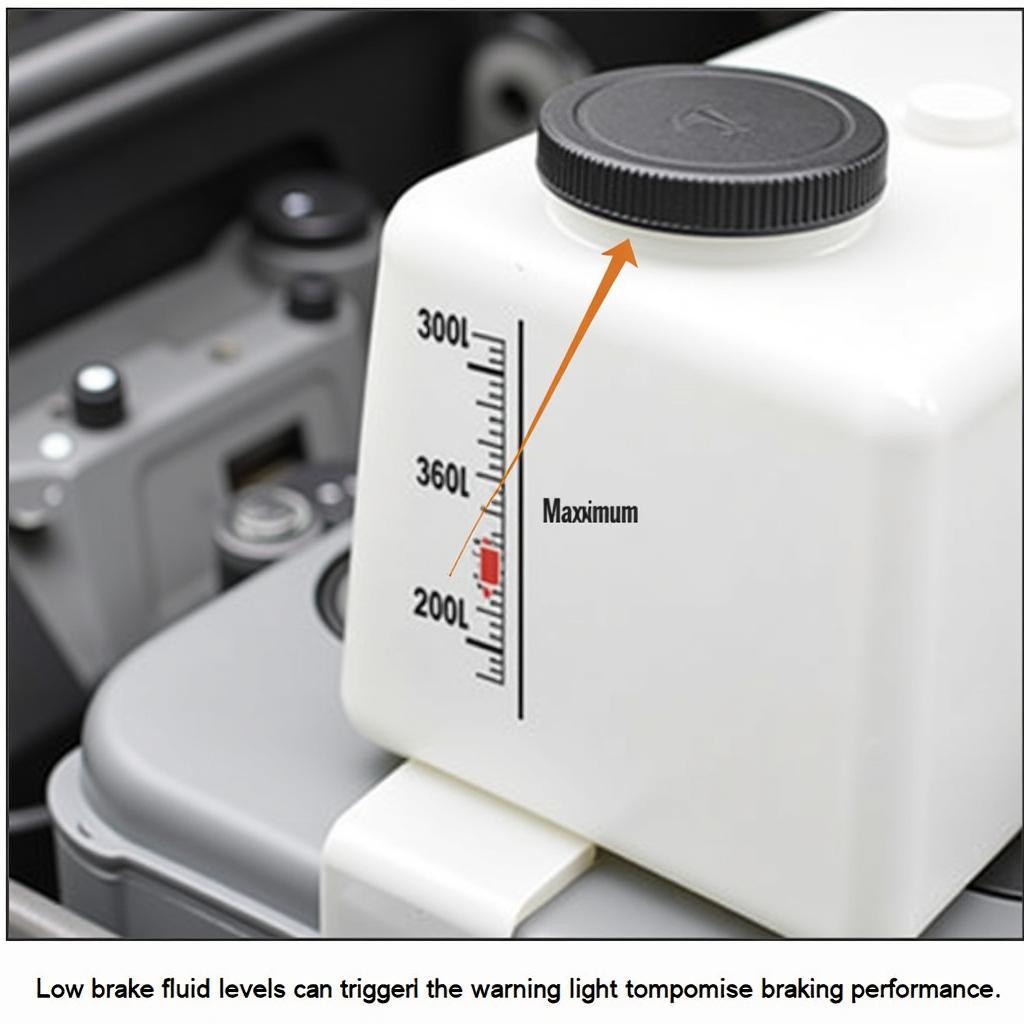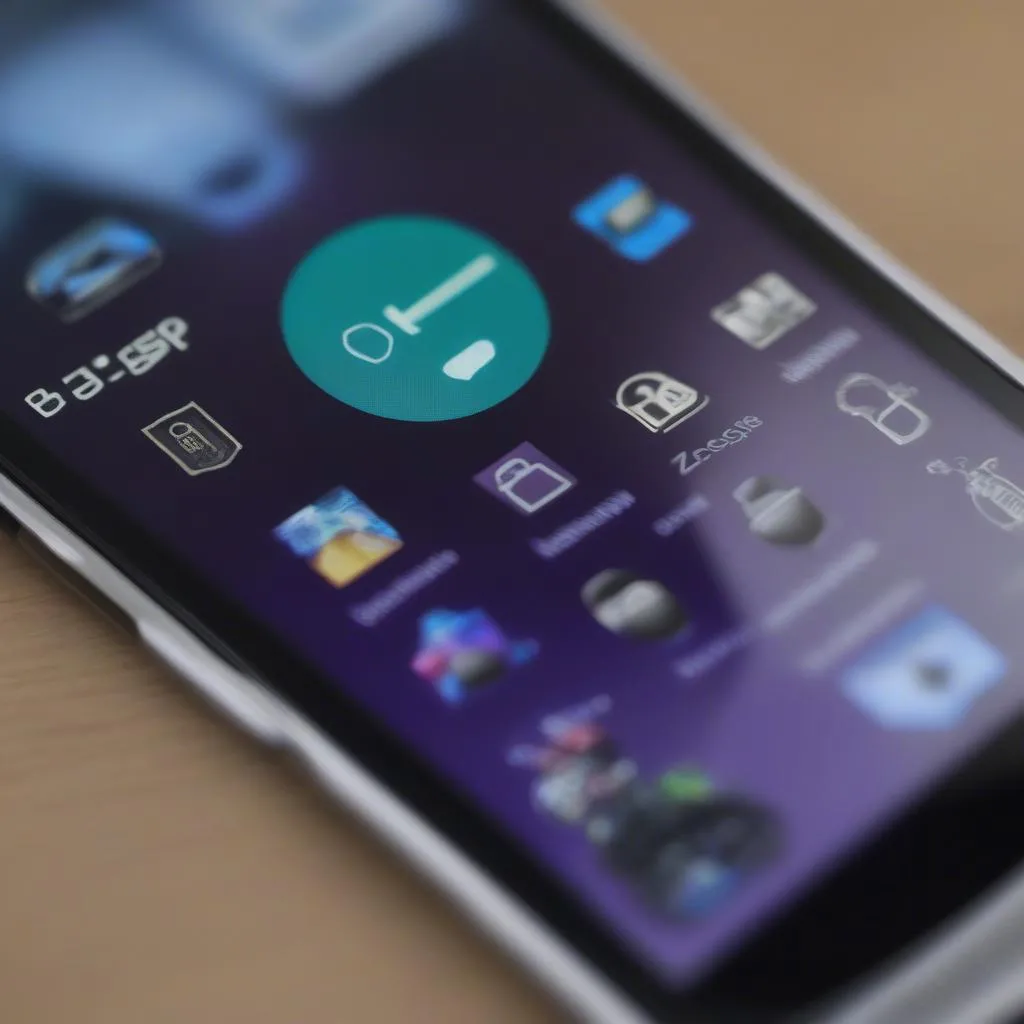The dreaded low brake fluid warning light flickers on in your 2006 vehicle – a sight that can send chills down any driver’s spine. This light, often accompanied by a persistent chime, signals a potential issue within your braking system, one that should never be ignored. But what exactly causes this warning light to illuminate, and more importantly, what steps should you take to address it? Let’s dive into the potential culprits and guide you towards a safe resolution.
Understanding Your Brake System
Before tackling the warning light, it’s essential to grasp the fundamentals of your vehicle’s braking system. In simple terms, your car relies on hydraulic pressure to engage the brakes. When you press the brake pedal, brake fluid amplifies this force, pushing the brake pads against the rotors to slow down or stop your vehicle.
 Brake Fluid Reservoir with Low Fluid Level
Brake Fluid Reservoir with Low Fluid Level
Common Causes of a 2006 Low Brake Fluid Warning Light
The most common reasons for the low brake fluid warning light in a 2006 vehicle fall into two main categories:
1. Brake Fluid Leak:
A leak in your brake lines, calipers, or wheel cylinders can lead to a drop in brake fluid level, triggering the warning light. This is a serious issue, as a leak compromises your braking ability, making it crucial to address immediately.
2. Worn Brake Pads:
As brake pads wear down over time, they require more brake fluid to function effectively. If your brake pads are significantly worn, the increased fluid demand can result in a lower fluid level in the reservoir, activating the warning light.
Diagnosing the Problem
Identifying the root cause of the low brake fluid warning light in your 2006 model involves a few key steps:
1. Check the Brake Fluid Level:
Park your car on a level surface and locate the brake fluid reservoir under the hood. The reservoir is usually a translucent plastic container with “brake fluid” clearly marked. Check the fluid level against the minimum and maximum lines. If it’s below the minimum, you likely have a leak.
2. Inspect for Leaks:
Carefully examine the area around the brake fluid reservoir, brake lines, calipers, and wheel cylinders for any signs of leaks. Look for wet spots, drips, or a damp residue, which could indicate a fluid leak.
3. Assess Brake Pad Wear:
Visually inspect your brake pads through the spaces between the wheel spokes. If the pad material is less than ¼ inch thick, it’s time for a replacement. You can find more information on this issue in our article about the 2006 chevy equinox brake warning light.
What to Do if Your 2006 Vehicle’s Brake Fluid Light Comes On
1. Don’t Panic:
While a serious issue, remain calm and pull over to a safe location as soon as possible.
2. Check Your Owner’s Manual:
Your owner’s manual will provide specific instructions for your vehicle model.
3. Add Brake Fluid (Temporarily):
If the fluid level is low and you suspect worn brake pads are the culprit, you can temporarily add brake fluid to reach the minimum line. However, this is only a temporary solution.
4. Seek Professional Help:
If you discover a leak or suspect a more serious issue, do not attempt to drive your vehicle. Contact a qualified mechanic or dealership immediately for proper diagnosis and repair. In some cases, remote diagnostics and software solutions can help identify the issue. To learn more about how remote services can help diagnose brake warning light issues, you can check out this informative article: 2006 silverado low brake fluid warning switch.
Preventing Future Issues
Regular Maintenance:
Schedule routine brake inspections with a trusted mechanic. This proactive approach helps identify and address potential issues before they escalate.
Timely Brake Pad Replacement:
Don’t wait for your brake pads to wear down completely. Replace them according to your vehicle manufacturer’s recommendations or as advised by a mechanic.
Quality Brake Fluid:
Use the brake fluid type and brand recommended in your vehicle’s owner’s manual.
Conclusion
Ignoring a low brake fluid warning light in your 2006 vehicle can lead to dangerous driving conditions. Understanding the potential causes, taking appropriate action, and prioritizing regular maintenance are essential steps in ensuring a safe and enjoyable driving experience. Remember, your safety and that of your passengers should always come first.
FAQ
1. Can I drive my car with the low brake fluid warning light on?
It’s highly discouraged to drive with the low brake fluid light on. Doing so could compromise your braking ability and lead to an accident.
2. How often should I check my brake fluid level?
It’s a good practice to check your brake fluid level at least once a month and more frequently if you notice any changes in your brake pedal feel.
3. How much does it cost to fix a low brake fluid issue?
The cost of repair depends on the underlying cause. A simple brake fluid top-up will be inexpensive, while fixing a leak or replacing worn brake components will be more costly.
4. Can I add any type of brake fluid to my car?
No, using the wrong type of brake fluid can damage your braking system. Always consult your owner’s manual for the recommended brake fluid type.
5. How long can I drive with worn brake pads?
Driving with worn brake pads is dangerous and can damage your rotors. Replace them as soon as you notice any signs of wear or according to your vehicle’s maintenance schedule.

